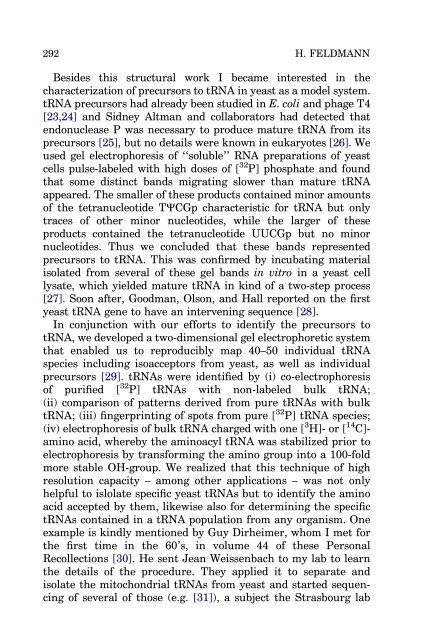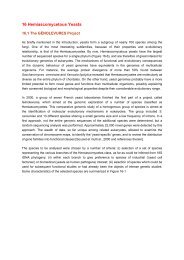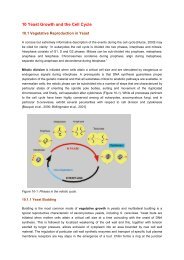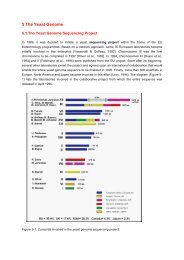A Life with Yeast Molecular Biology - Prof. Dr. Horst Feldmann
A Life with Yeast Molecular Biology - Prof. Dr. Horst Feldmann
A Life with Yeast Molecular Biology - Prof. Dr. Horst Feldmann
Create successful ePaper yourself
Turn your PDF publications into a flip-book with our unique Google optimized e-Paper software.
292<br />
H. FELDMANN<br />
Besides this structural work I became interested in the<br />
characterization of precursors to tRNA in yeast as a model system.<br />
tRNA precursors had already been studied in E. coli and phage T4<br />
[23,24] and Sidney Altman and collaborators had detected that<br />
endonuclease P was necessary to produce mature tRNA from its<br />
precursors [25], but no details were known in eukaryotes [26]. We<br />
used gel electrophoresis of ‘‘soluble’’ RNA preparations of yeast<br />
cells pulse-labeled <strong>with</strong> high doses of [ 32 P] phosphate and found<br />
that some distinct bands migrating slower than mature tRNA<br />
appeared. The smaller of these products contained minor amounts<br />
of the tetranucleotide TCCGp characteristic for tRNA but only<br />
traces of other minor nucleotides, while the larger of these<br />
products contained the tetranucleotide UUCGp but no minor<br />
nucleotides. Thus we concluded that these bands represented<br />
precursors to tRNA. This was confirmed by incubating material<br />
isolated from several of these gel bands in vitro in a yeast cell<br />
lysate, which yielded mature tRNA in kind of a two-step process<br />
[27]. Soon after, Goodman, Olson, and Hall reported on the first<br />
yeast tRNA gene to have an intervening sequence [28].<br />
In conjunction <strong>with</strong> our efforts to identify the precursors to<br />
tRNA, we developed a two-dimensional gel electrophoretic system<br />
that enabled us to reproducibly map 40–50 individual tRNA<br />
species including isoacceptors from yeast, as well as individual<br />
precursors [29]. tRNAs were identified by (i) co-electrophoresis<br />
of purified [ 32 P] tRNAs <strong>with</strong> non-labeled bulk tRNA;<br />
(ii) comparison of patterns derived from pure tRNAs <strong>with</strong> bulk<br />
tRNA; (iii) fingerprinting of spots from pure [ 32 P] tRNA species;<br />
(iv) electrophoresis of bulk tRNA charged <strong>with</strong> one [ 3 H]- or [ 14 C]amino<br />
acid, whereby the aminoacyl tRNA was stabilized prior to<br />
electrophoresis by transforming the amino group into a 100-fold<br />
more stable OH-group. We realized that this technique of high<br />
resolution capacity – among other applications – was not only<br />
helpful to islolate specific yeast tRNAs but to identify the amino<br />
acid accepted by them, likewise also for determining the specific<br />
tRNAs contained in a tRNA population from any organism. One<br />
example is kindly mentioned by Guy Dirheimer, whom I met for<br />
the first time in the 60’s, in volume 44 of these Personal<br />
Recollections [30]. He sent Jean Weissenbach to my lab to learn<br />
the details of the procedure. They applied it to separate and<br />
isolate the mitochondrial tRNAs from yeast and started sequencing<br />
of several of those (e.g. [31]), a subject the Strasbourg lab







